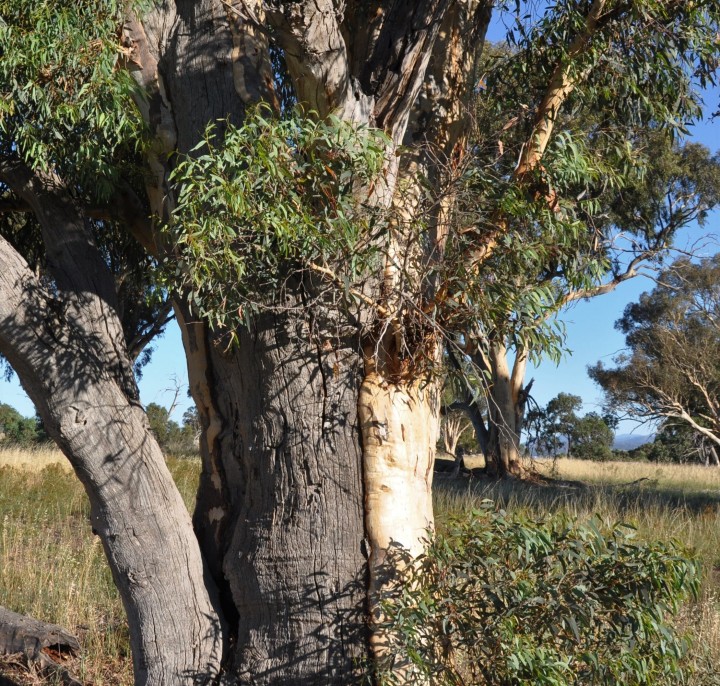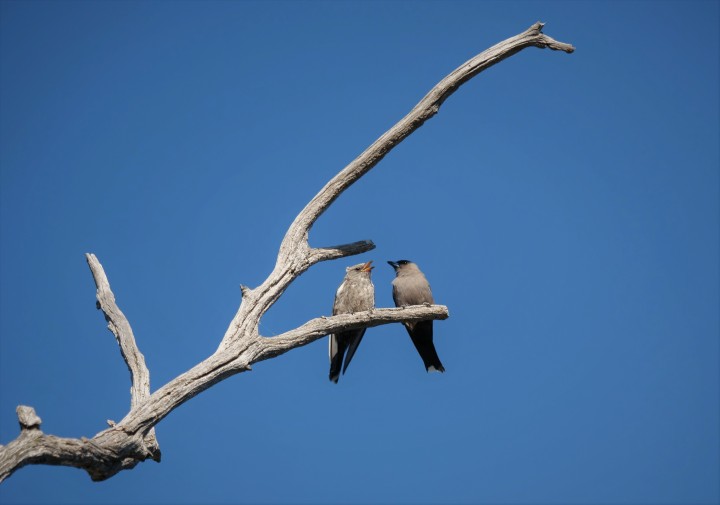Once upon a time, yellow box and red gum grassy woodlands stretched from Toowoomba to Victoria (Australia), providing a continuous wildlife corridor 100-150 kilometres in width and 1,500 km in length. Since colonisation, vast swathes of grassy woodland have been cleared for agriculture. Now there may be as little as 1-5 percent remaining. most of which has been modified in some way by grazing. Many birds and animals have become trapped in isolated communities, reducing valuable genetic diversity and leaving them vulnerable to threats of local habitat loss. It is not surprising then, that yellow box and red gum grassy woodlands have been declared a critically endangered ecological community.


In Canberra we are fortunate enough to have a number of these woodlands that provide habitat for a wide variety of birds, plants and animals, including a number of rare and endangered species. My love and I recently took a walk in one of these woodland reserves. The place was teeming with birds. The reserve contains many dead trees and fallen timbers ideal for nesting, plus abundant open grasslands favoured by raptors.
Summer migrants, the dusky woodswallows, were in attendance in quantity. Almost every dead tree had a family on board.




There were also quite a few parrots and thornbills. These darted ahead of us taking cover in the long grass, so no photos. My kestrel and dollar bird photos also left a lot to be desired, so I will leave those for another time. Still, we managed a couple of fairly ordinary photos of the grey fantail. There is such a thing as too much bokeh in my opinion. My camera doesn’t seem to do it well (or maybe it is operator error).


The shot of the day was of a little varied sitella rocking a punk hairstyle. They don’t normally have tufted heads, but they do vary quite a lot, hence the name. I suspect it is a chick. Isn’t it sweet?

Have I told you the story of the Unexploded Ordinance? No? Stay calm. That’s a story for another day. I’ll leave you with one last tree photo to help you relax.

Kind Regards
Tracy
Response to the Lens-Artists Photo Challenge — Nature. Thank you, Patti. Click on the link to check out other contributions and to find out how to participate.
Beautiful post, Tracy. We haven’t explored that part of Oz yet, but we will! Lovely nature shots.
LikeLiked by 2 people
Thank you, Patti. Next time you come to Australia, you really should try to make it to Canberra. It is a most overlooked tourism destination. We have everything, except the coast. 🙂
LikeLiked by 1 person
We will, Tracy. There is so much to see in your magnificent country. This time we explored Tassie and Melbourne, in addition to Sydney. We’ll need another month next time!
LikeLiked by 1 person
At least a month, Patti. 🙂
LikeLike
I want to holiday in your neck of the woods! Gorgeous photos.
LikeLiked by 2 people
I try not to over-hype, dawnbird, but I really do love it here.
LikeLiked by 2 people
What’s not to love about the bush, Tracy! A magic place. Your photographs are awesome.
LikeLiked by 1 person
Good camera, dawnbird. 🙂 I’ve almost learnt how to manual focus.
LikeLiked by 1 person
It really is. You are way ahead of me! lol
LikeLiked by 1 person
Your photos are beautiful, Tracy. The rock star is adorable, but I really like the three birds sitting together.
LikeLiked by 2 people
Thank you, Lois. Those three were very sweet. 🙂
LikeLike
Stunning photos once again. My favourites are photo 4 and 5. I just love how you captured the two birds conversing!
LikeLiked by 2 people
Thank you, Heather. I think the chick is saying “Feed me, feed, me.” 🙂
LikeLiked by 1 person
I have been privileged to see some parts of the Canberra bushland on my many visits in the past but not this part (yet). I grieve the loss of corridors, it is the same here, though some work is being done in the south to repair some of it. The Mallee Fowl group have succeeded in getting some protection of corridors.
LikeLiked by 2 people
We seem to be always trying to fix problems, Paul, rather than preventing them in the first place. I’m glad the Mallee Fowl group has had some success. Many are working to re-establish the Box gum grassy woodlands but it is unlikely we will ever see a continuous corridor again.
LikeLiked by 1 person
O, that is sad, we are close to a corridor. We have one for the famous Bibbulmun track, and one for the Mallee fowl in process. I hope you Canberrans get close.
LikeLiked by 1 person
I think it is the NSW and Qld people that are the issue. 😦
LikeLike
Some beautiful captures here, Tracy! I love the three birds on the branch!
LikeLiked by 3 people
Thank you, Sue. I’m lucky they were stillish for a few moments. 🙂
LikeLiked by 1 person
We have the same problems here. Over the past couple of decades huge swaths of the the American prairie have been set aside as native grass preserves. I honestly don’t know how they got the good grasses to win over the seeds that had been transported in cattle dung or bird seed, but it seems they did. Out there, trees are a non-issue. Pretty much the only ones that MIGHT grow are cottonwoods and willow, but only by streams. It’s funny how we “don’t know what [we’ve] lost til it’s gone.” I love the punked out chick. He’s amazing.
LikeLiked by 1 person
I had heard about that work there, Martha, and am so pleased that it has met with success. The buffalo and other migratory animals that rely on it must be happy too. I suppose it is easy not to notice how much is lost when it occurs slowly over time.
LikeLiked by 1 person
And the mentality of the prairie destroyers lasted over 100 years and they weren’t malicious, poor guys, not that that really matters. “My” bison live on a ranch. I should take pictures. When I first saw it, I didn’t see the bison and I wondered, “Why does that guy have a fence made out of telephone poles around his house?” but once I saw the buffalo I understood. They’re so big and so powerful.
LikeLiked by 1 person
I’ve only seen two in my life. In a cow paddock in a small country town here. WTF was my first reaction. 🙂 Thanks for reminding me they are bison and not buffalo.
LikeLiked by 1 person
Great information Tracy. I was doing stuff with the Yellow Box Red Gum grassy woodlands many many years ago. Pity only a few landowners got on board. If you think that you have too much bokeh in a photo, just crop down to what you like and the subject is in the right spot. I also increase the black and drop the lightness using highlights to enhance the subject.
LikeLiked by 2 people
Thank you, Brian. Some people get so stubborn about “being told what to do”, and I think they object on principle. Plus, they don’t want to know. It was worth trying though. Do you get many dusky woodswallows in your area? I read that they were listed as vulnerable in NSW.
Also thanks for the photography tips. I’m slowly learning the work arounds.
LikeLiked by 1 person
I have had the Dusky Wood-swallows here in the past. Not seen any for a while now. Glad I could help with a few tips 🙂
LikeLiked by 1 person
Beautiful post and images. I love birds.
LikeLiked by 2 people
Thank you, Robert. Life is a better place because of the birds. 🙂 I couldn’t live without them.
LikeLiked by 1 person
I’m inspired to work on my birds photos. 🙂
LikeLiked by 1 person
Good. Let me know when you’ve done that. I would love to see them.
LikeLiked by 1 person
I will. I’ll make it soon.
LikeLiked by 1 person
Loss of habitat is so sad for our native birds and animals. Your photos are stunning I love the bokeh effect
LikeLiked by 2 people
Thanks Pauline. The camera loves the birds. I think I need a bigger lens to dampen down the bokeh. It doesn’t look so great on max zoom. Too swishy. First world problem, eh.
LikeLiked by 1 person
Isolated pockets of wildlife are a complex issues in Canada. Recent research has shown that the territorys for many of the larger predators such as grizzly bears and cougars are too small which sometimes bring them face-to-face with hikers and joggers. Some of these encounters have proven to be fatal to animals and to humans. Recently a man fought with his bare hands and killed a cougar. One does not want to have a surprise meeting with a sow and her cubs. Part of the solution has been to set up large national parks which are not always contiguous hence the potential animal/human encounters. Fabulous photographs Tracy, but my fear of snakes would have me observing from from the safety of a vehicle. LOL
LikeLiked by 1 person
Wow, Sid. Man versus cougar. The stuff of legends. But seriously scary. I feel the same way about your large predators.
Have to be careful of snakes in the long grass, but if they hear you coming, they normally slide away. There were mown paths. Did we stick to them? No. I insist my son takes a EPIRB when he hikes and some compression bandage, and wears gaitors. Did I have any of those things? Nup. I was a bit nervous in the longer grass.
LikeLike
I admire your caution. We have rattle snakes that give a warning before they strike. Their venom is slow acting and painful but will respond to immediate medical attention. The mother bear sends her cubs up a tree and at that point one must also be up a tree or in the worst case scenario be good at playing dead.
LikeLiked by 1 person
Hope you’re good at climbing. I’m not. 🙂
LikeLike
Looks like a great escape from the humdrum of city life!
LikeLiked by 2 people
And only a two minute drive from home, Dries.
LikeLiked by 1 person
Places like that is so precious! I hope everyone in the neighbourhood values it as much as you?
LikeLiked by 1 person
I suspect very few people from my neighbourhood know (or care) that there is a reserve there. It is frequented by birders and ecologists/scientists. Most people just tend to admire it from their car as they drive past.
LikeLiked by 1 person
How sad for them!
LikeLiked by 1 person
Nice photos! These guys are so expressive in the photos you took, they are like chatters, which I have not made it well in capturing them! 🙂
LikeLiked by 2 people
Thank you, Makiko. Those birds were pretty mobile. I had to be quick. 🙂
LikeLiked by 1 person
Very nice, thank you! But, please, can you explain “bokeh”? Thank you Tracy!
LikeLiked by 2 people
Bokeh is the blurry bits in the background where you get a blending of colours. 🙂
LikeLiked by 1 person
Thank you! It’s a lovely word; I’ve got a lot of photos with that both in the background and the foreground, I wonder what you would call that!! Ha ha!!
LikeLiked by 1 person
An experiment. 🙂
LikeLiked by 1 person
Lovely post, and such cute models!
LikeLiked by 2 people
Thanks Irene. 🙂
LikeLiked by 1 person
Great pictures!
LikeLiked by 2 people
Thank you.
LikeLike